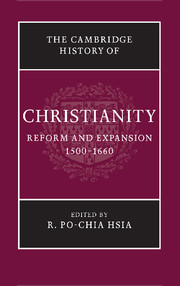Book contents
- Frontmatter
- Part I Luther and the Holy Roman Empire
- Part II The Second Reformation
- Part III Catholic Renewal
- 9 Redefining Catholicism: Trent and Beyond
- 10 New religious orders for men
- 11 Female sanctity, 1500–1660
- 12 Tridentine worship and the cult of saints
- Part IV Resolving Confessional Conflicts
- Part V Religion, Society, and Culture
- Part VI Christianity and Other Faiths
- Bibliography
- Index
- References
12 - Tridentine worship and the cult of saints
from Part III - Catholic Renewal
Published online by Cambridge University Press: 28 March 2008
- Frontmatter
- Part I Luther and the Holy Roman Empire
- Part II The Second Reformation
- Part III Catholic Renewal
- 9 Redefining Catholicism: Trent and Beyond
- 10 New religious orders for men
- 11 Female sanctity, 1500–1660
- 12 Tridentine worship and the cult of saints
- Part IV Resolving Confessional Conflicts
- Part V Religion, Society, and Culture
- Part VI Christianity and Other Faiths
- Bibliography
- Index
- References
Summary
Introduction – reforming liturgy after Trent
Central to the Tridentine reaffirmation of the divinely-ordained nature of the Holy Roman Church was the assertion of papal magisterium. While conflicts with the secular authorities over rights of ecclesiastical patronage in general, and episcopal appointment in particular, have long received the attention of scholars, considerably less notice has been taken of an area in which the papacy took a highly visible lead in the immediate aftermath of Trent. This concerned the reform of liturgy, which the Council of Trent in its final (25th) session had left entirely to papal discretion. In the space of less than fifty years, from the publication of the revised Roman Breviary (1568) to the issue of the revised Roman Ritual (1614), the Roman Church undertook the unprecedented step of providing texts which were to possess universal validity and authority. In what follows, discussion will be focused on the reform of the breviary, not only because the issues raised most directly concern the cult of saints, but also because the processes involved tell us much about the reception and interpretation of Tridentine reforms in general.
Members of the reforming commission sought not to innovate but ‘to strip the office back to its antique [simplicity]’ (ridur l’officio all’antico). In Pius V’s words, the aim was to reclaim ‘the original standard of the Fathers’ (pristina patrum norma) so as to permit the more frequent saying of the daily ferial (i.e. non-feast day) office. The latter was centred on readings from the psalms (all 150 of which were meant to be covered each week), together with other key passages from scripture (many of which were accompanied by short homilies, not infrequently of patristic authorship).
- Type
- Chapter
- Information
- The Cambridge History of Christianity , pp. 201 - 224Publisher: Cambridge University PressPrint publication year: 2007
References
- 9
- Cited by



